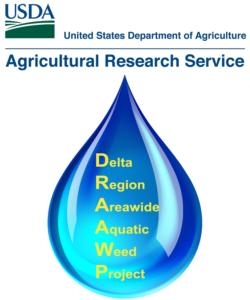
Seasonal growth and phenology of water hyacinth, curlyleaf pondweed, and Brazilian egeria in the Sacramento-San Joaquin River Delta
John D. Madsen, Christy M. Morgan and John Miskella
Abstract
The Sacramento–San Joaquin River Delta (hereafter the ‘‘Delta'') is a 28,000-ha (68,000 acre) tidal estuary formed by the Sacramento River and the San Joaquin River. The seasonal growth of water hyacinth (Eichhornia crassipes (Mart.) Solms), Brazilian egeria (Egeria densa Planch.), and curlyleaf pondweed (Potamogeton crispus L.) were studied to improve adaptive management of these species from May 2015 through December 2017 by sampling 3 separate sites by collecting 12 or 15 biomass samples taken with either a 0.1-m2 quadrat (floating plants) or a 0.0225-m2 Ekman dredge (submersed plants) at each site per month. Samples were sorted to relevant plant parts, dried at 70 C, and weighed. Water hyacinth biomass peaked in early fall, reaching as high as 2,500 g dry weight (gDW) m—2. Leaves senesced in the winter, reaching a minimum of 300 gDW m—2, composed mostly of stem bases. Egeria biomass did not vary significantly over the season, ranging between 200 and 400 gDW m—2. Curlyleaf pondweed biomass reached a peak of 400 gDW m—2 in midsummer, dying back to turions in the winter. Water hyacinth stem base total nonstructural carbohydrates (TNCs) ranged from almost 0 to 30% DW, with a distinct minima in June of each year. Curlyleaf pondweed turion TNCs ranged from 20 to 60% DW, with a peak in July and a low point in February. Egeria shoot TNC was consistently lowest in late spring (April or May). Phenological studies inform managers regarding the initiation of growth, and the timing of significant propagule formation.
Authors
- John D. Madsen, Research Biologist, USDA–ARS ISPHRU, Department of Plant Sciences, University of California, Davis (jmadsen@ucdavis.edu)
- Christy M. Morgan, Biological Research Technician, USDA–ARS ISPHRU, Department of Plant Sciences, University of California, Davis
- John Miskella, Biological Research Technician, USDA–ARS ISPHRU, Department of Plant Sciences, University of California, Davis